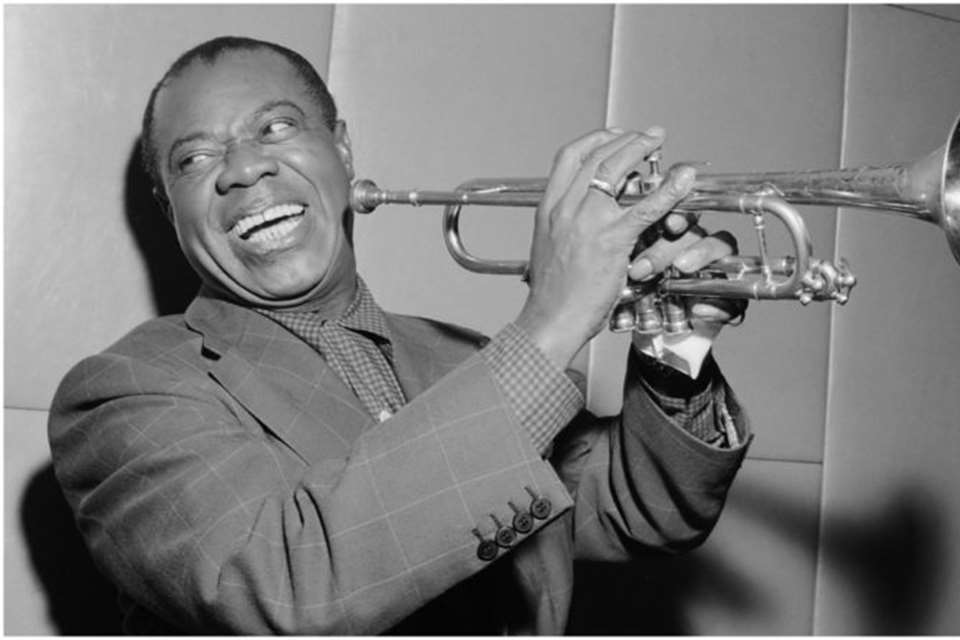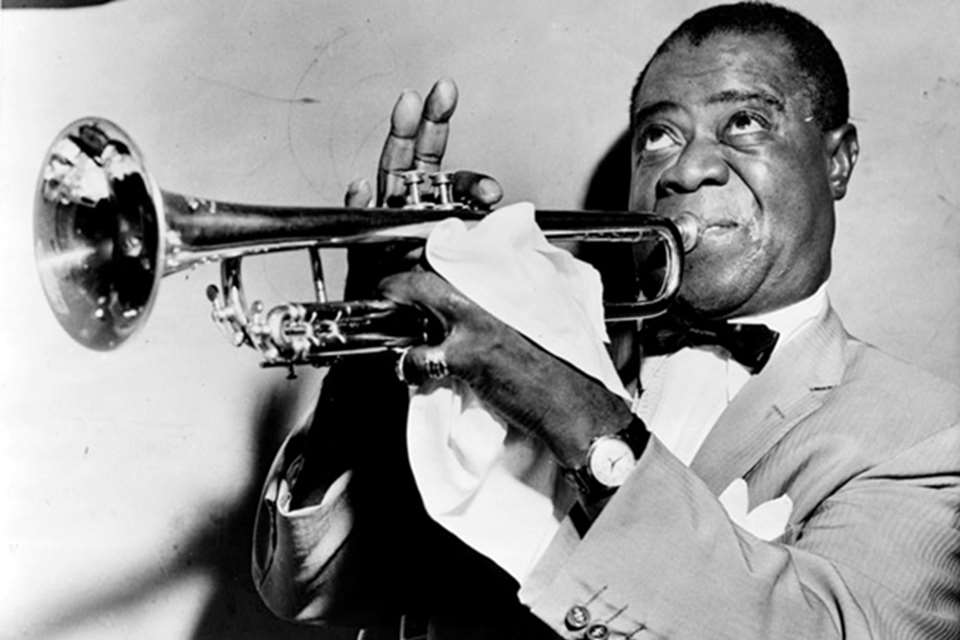Louis Armstrong: 50 Years On And Still On Song
Alyn Shipton
Friday, June 18, 2021
It is now half a century since the death of jazz titan Louis Armstrong. As Mosaic releases a comprehensive box set covering the period 1946-66, Alyn Shipton looks back at the musical, cultural and political impact of a true 20th century icon. Photos courtesy of the Louis Armstrong House Museum/Jack Bradley Collection
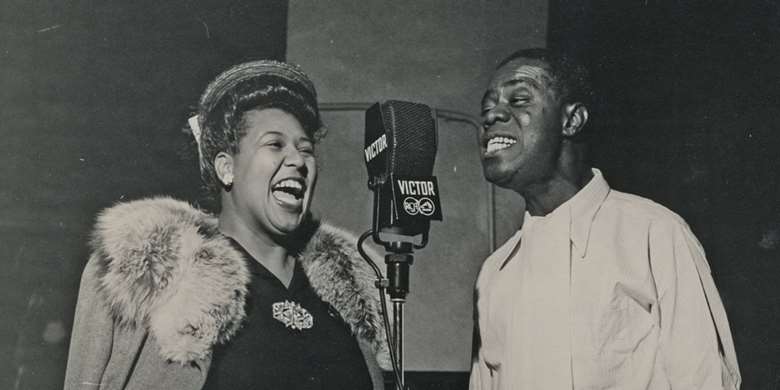
On 6 July 1971, the world lost Louis Armstrong, the first great soloist in jazz, and one of the music’s finest and most successful ambassadors for almost all his adult life. So, 50 years on, it seems a good moment to look back on his extraordinary career, not least because in one of those moments of synchronicity, 4 August 2021 will be – despite Louis believing he was born 13 months earlier on 4 July 1900 – the 120th anniversary of his birth in New Orleans.
“You can’t play nothing on the trumpet that doesn’t come from him, not even modern shit. I can’t remember a time when he sounded bad playing the trumpet. Never.” – Miles Davis
If there’s one word that sums up Louis, it is ‘soul’. To listeners worldwide, then and now, and to those who knew him and played alongside him, it’s hard to disagree with his one-time dep and lifelong admirer Doc Cheatham, who said, “I learned a lot from Freddie Keppard and Joe Oliver and the rest of them in 1920s Chicago, but I thought that Louis was just about the greatest thing I’d ever heard. None of the others had the soul that Louis had”. And Miles Davis, the only other trumpeter who had a comparable lifelong influence on the course of jazz to that of Louis, wrote: “You can’t play nothing on the trumpet that doesn’t come from him, not even modern shit. I can’t remember a time when he sounded bad playing the trumpet. Never.”
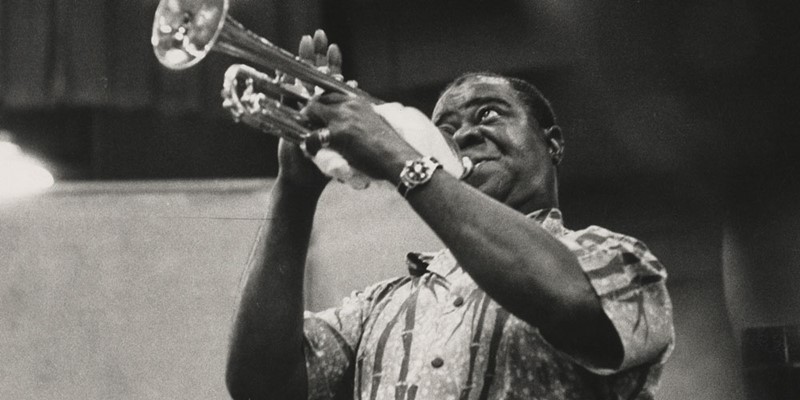
Pops blows at a Columbia Studios NYC session, 26 April 1955
Lately – and with the significant anniversaries of his birth and death in mind – there’s been a lot of activity concerning Louis. The Mosaic set of his RCA and Columbia recordings, reviewed in the last issue of Jazzwise, parallels the recent appearance of several previously unissued concerts from Armstrong’s later career. Ricky Riccardi’s new survey of his big band years, Heart Full Of Rhythm, seeks to revalue a period some critics have overlooked, just as Riccardi’s earlier book similarly explored the All Stars period. Even if you don’t quite see eye to eye with Berklee College of Music’s Matt Glaser, who linked Louis’ rhythmic innovations to the theories of Albert Einstein in a 20-year old article that’s recently been cited in various academic papers, there’s no doubt about his impact on 20th century music, which as Glaser says, ‘changed the human experience of time’.
And just before the pandemic, I was at a conference at Columbia University in New York, where Penny Von Eschen spoke eloquently about Louis’ political achievements, particularly in representing American culture behind the iron curtain during the Cold War years. As she says in her recent book Satchmo Blows Up The World, he ‘broke through the government’s official narrative and gave audiences an unprecedented vision of the black American experience’. This year’s follow-up online event at Columbia saw a panel exploring Louis’ influence on 21st century jazz musicians, including such varied players as Jason Moran and drummer Bobby Sanabria, showing that he’s as relevant today as at any stage during his professional life.
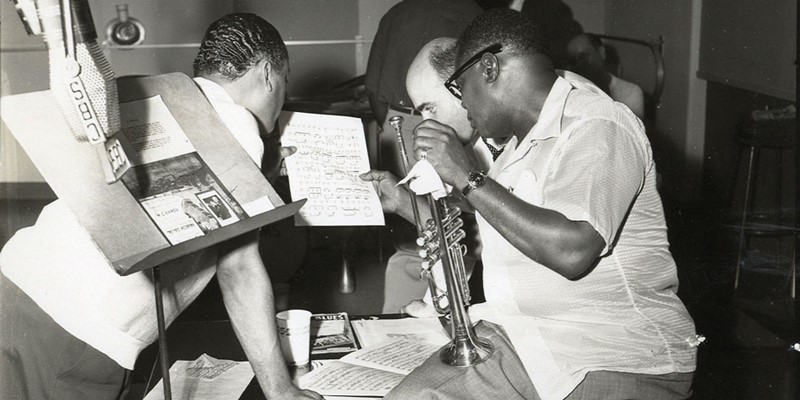
Columbia Chicago studio session, 13 July 1954
What’s so compelling about Louis’ story is that it happened at all, and that from the grinding poverty and violence-ridden ‘battlefield’ back-of-town neighbourhood of Jane’s Alley in New Orleans, he survived to become jazz’s first superstar.
After a troubled childhood in the Crescent City and a period in the waif’s home, it’s a well-known story that Louis was invited to Chicago to join King Oliver’s band in August 1922, and that his musical career took off under the wing of his older, cornet-playing mentor. Prior to Louis’ arrival, Oliver’s band had not used a second cornet, but the two immediately gelled, and their playing enthralled audiences at the Lincoln Gardens, which held around 700 patrons. We do not have a sound document of the band with the female pianist Bertha Gonsoulin, who was there when Louis arrived, but when Lil Hardin – Louis’ future wife – rejoined (she had previously worked with Oliver on the West Coast) the lineup was set for making its first recordings in April 1923.
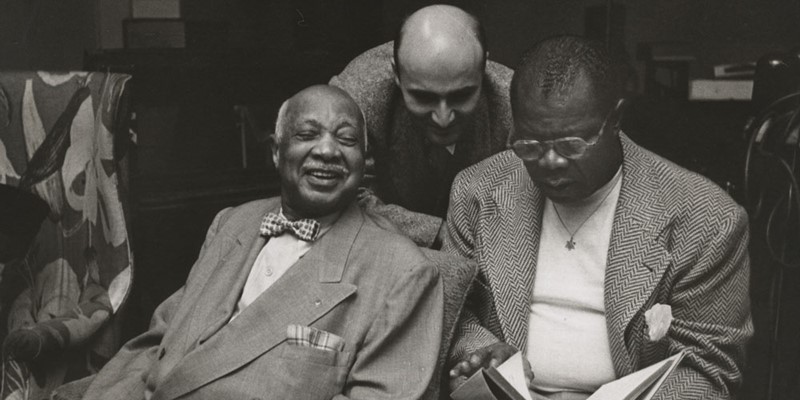
WC Handy, Avakian and Armstrong take a break, NYC 3 September 1954
From that first date, which produced such classics as ‘Canal Street Blues’ and ‘Dippermouth Blues’, (with banjoist Bill Johnson’s impromptu shout of ‘Oh Play that thing!’ becoming an integral part of the composition), Louis went on to make hundreds, if not thousands, of recordings. In a brief stint in New York, following his time with Oliver, he transformed the timing and swing feeling of the Fletcher Henderson band. Then he was back in Chicago, fronting bands in theatres such as the Vendome, and nightclubs such as the Sunset, as well as leading his own small groups in the studio. Although most histories say that Louis’ Hot Five were only ever a recording band, I recently discovered that they did appear on stage at least once, at Chicago’s Savoy Ballroom, in March 1928. They were part of an all-night ‘monster theatrical bill’ featuring no fewer than 27 acts – the group including clarinetist Darnell Howard, trombonist Kid Ory and drummer Zutty Singleton (but sadly the Baltimore Afro-American report I unearthed does not list the pianist!)
The following year saw Louis in New York, starring each night on Broadway and uptown at Harlem’s Connie’s Inn in Fats Waller and Andy Razaf’s revue Hot Chocolates. Just as this production would later transform Cab Calloway’s career, it put Armstrong on the map. As Ricky Riccardi says, Louis’ recording of ‘Ain’t Misbehavin’’ from the show, when compared to other records of the time by the likes of Gene Austin or Ruth Etting, sounds so modern that it’s as if ‘it was from another planet’. Even more significant, given the recent focus on Louis’ political activity, is the way he transformed the show’s ‘Black and Blue’ from a vehicle for comedienne Edith Wilson into a protest song, focusing on ‘My only sin is in my skin’. As Riccardi reports, Louis told an interviewer, ‘I used to sing it serious, like shame on you for this and that’.
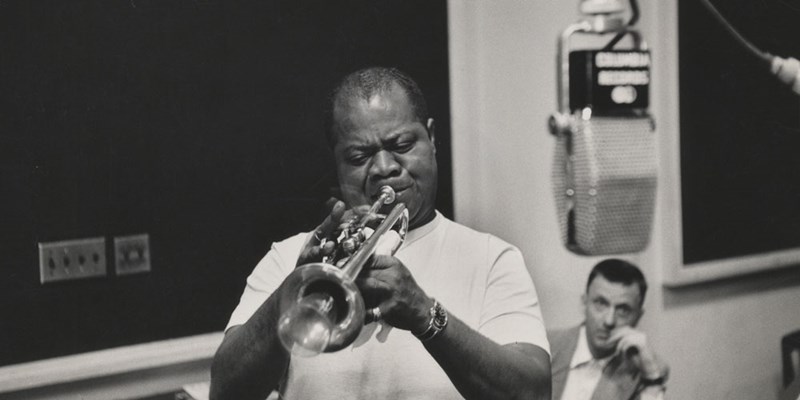
Pure concentration while recording Louis Armstrong Plays WC Handy
Sadly, Louis and the composer of those songs, Fats Waller, very seldom worked together. The one documented occasion was Martin Block’s radio show Make Believe Ballroom, which was recorded off the air. Guitarist Al Casey was on that broadcast with Fats’ band, and he remembered: “We did that live on the programme, and Louis and Fats worked together just like that! They were so good together it’s a shame they never worked more often!” Al later played with Louis on a couple of all-star Esquire Award Winners shows in the 1940s, and in common with Doc Cheatham, what he remembered most was the soul in Louis’ playing. Another guitarist who worked with Louis (and is on his famous double-sided 78 of ‘Skokiaan’) was Danny Barker. When we were writing his autobiography he told me, “All the alert jazz musicians and music lovers waited anxiously for each of Louis’ latest releases, as there was much to learn from these classics.”
Yet it wasn’t just a question of records. Louis was one of the first African-American entertainers to break into movies. There’s work to be done by jazz scholars on this, to produce a thorough critical account of his 35 or so screen appearances. It is true that often, particularly in the early years, he was cast in menial roles, or on one occasion sings to a horse, as he does during ‘Jeepers Creepers’ in 1938’s Going Places. Yet later in the same film he fronts his elegant big band in ‘Mutiny in the Nursery’, and increasingly he has the dignity of this more formal setting as the 1940s went on, making a stand against Hollywood’s accustomed casting of African Americans. His guitarist of the time, Lawrence Lucie, alerted me, for example, to the 1944 film Jam Session, in which Louis’ Orchestra – the only African-American band to appear – comprehensively outplays Charlie Barnet, Alvino Rey and the Casa Loma Orchestra. By the time of High Society in 1956, Louis was a star on equal terms with Bing Crosby.
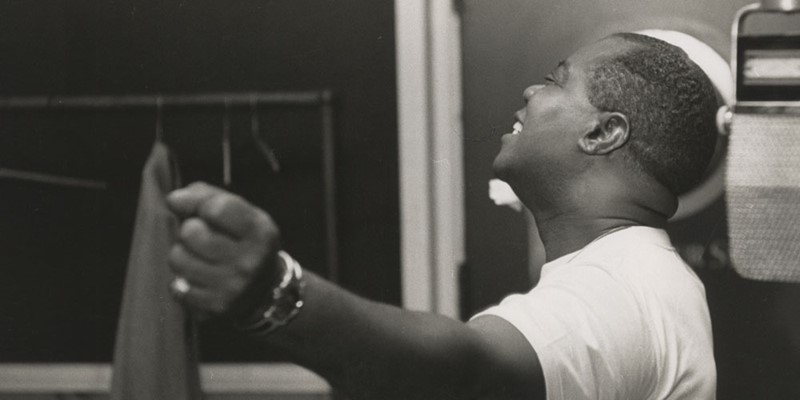
From the Louis Armstrong Plays WC Handy sessions
It was a year after that, in September 1957, that Louis blew up in a press interview with trainee journalist Larry Lubenow, and – following Arkansas Governer Faubus’s decision to send the National Guard to keep nine Black schoolchildren out of their chosen High School, and President Eisenhower’s decision not to censure him – Armstrong was quoted as saying that the President was ‘two faced’ and ‘had no guts’.
The first full account of this episode was in Terry Teachout’s admirable biography Pops, from 2009, which reminds us that in the end Eisenhower capitulated and the nine children were admitted to Central High in Little Rock. As Teachout points out, “Armstrong was regarded by the State Dept. as perhaps the most effective goodwill ambassador this country had”. He speculates that it was Armstrong’s value to other nations’ perception of the USA rather than the wish to come down hard on Faubus that motivated the President, but it is an excellent illustration of Armstrong’s ‘soft power’.
By this time, Louis’ last regular band, the All Stars, had been in operation for 10 years. It had its ups and downs, and as Arvell Shaw, its long-term bassist reminded me, it was never a good idea when the lineup included any other big stars apart from Louis, especially one who had rivalled him in the 1920s. “Earl Hines was all over the piano, all at once, with both hands,” he recalled. “He was flying. It was kinda difficult to play with him because you never knew where he was going. He didn’t play anything the same way twice. In the All Stars we would get something together with him and play it maybe a couple of times. Then next time he’d go somewhere else. You could never relax playing with Earl Hines.” For a band that stuck to its well-worn concert routines the way Louis liked, this was not ideal, and I gather from talking to more than one of the members of the band over the years that it was a relief when the more avuncular Billy Kyle joined on piano.
The band’s musical high points include the two Columbia albums Satch Plays Fats and Louis Armstrong Plays W C Handy, although from 1947 until the start of the 1960s, the band was remarkably consistent. During that time, Louis himself regarded the version with clarinetist Ed Hall and trombonist Trummy Young, with Kyle, Shaw and drummer Barrett Deems, as his best, saying, “The audience appreciate the spirit in the band… these boys seem like they’re real glad to be up there swinging with me.”
This didn’t stop Louis from making other records, such as the fine session with Duke Ellington or his three-album collaboration with Ella Fitzgerald. Ray Brown, who played bass on the first two Ella and Louis albums summed up for me what Louis meant then, and what he means now, better than anyone else, when he said, ‘Louis Armstrong was practically everybody’s idol. He was almost like the guy that invented jazz for most of us. And nobody probably did it any better than he did.’
Mosaic’s new 7-CD box set, The Complete Columbia and RCA Victor Sessions 1946-1966 is available now, exclusively via www.mosaicrecords.com
This article originally appeared in the June 2021 issue of Jazzwise. Never miss an issue – subscribe today
